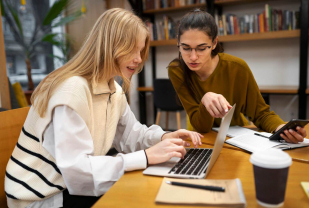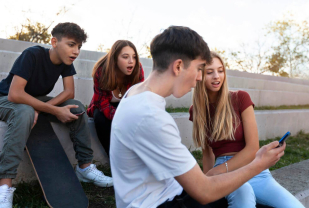Do you know your learning style?
Some students will confidently give a definitive answer to this question. Others might hesitate. However, regardless of which category you fall into, you have probably heard about this idea at least once in your life.
The concept of “learning styles” is still greatly favored in schools and colleges. Many educators rely on it in their day-to-day teachings. However, despite its popularity, empirical evidence for the benefits of this theory are limited. Numerous online publications are quick to point that out and discredit this concept entirely.
So, are learning styles completely useless?
We don’t think so! In this article, our experts scrutinize their credibility and offer alternative ways of thinking about this theory. We’ll also discuss various learning styles and how to use them. Finally, you will find some practical examples on how to use different learning approaches in your education to ensure maximum efficiency.
📚 What Are Learning Styles?
Learning styles refer to how students obtain, process, understand, and retain information. The idea is fairly simple – every person has a particular way of learning that suits them best. When sticking to it, we memorize information and understand concepts much better than we would otherwise.
Thus, auditory learners thrive when listening, discussing topics, and participating in debates. Kinesthetic students use gestures to express ideas and learn best from hands-on experience. A read/write style emphasizes written exercises and plenty of reading. Visual learners organize their learning experience via images, graphs, and pictures.
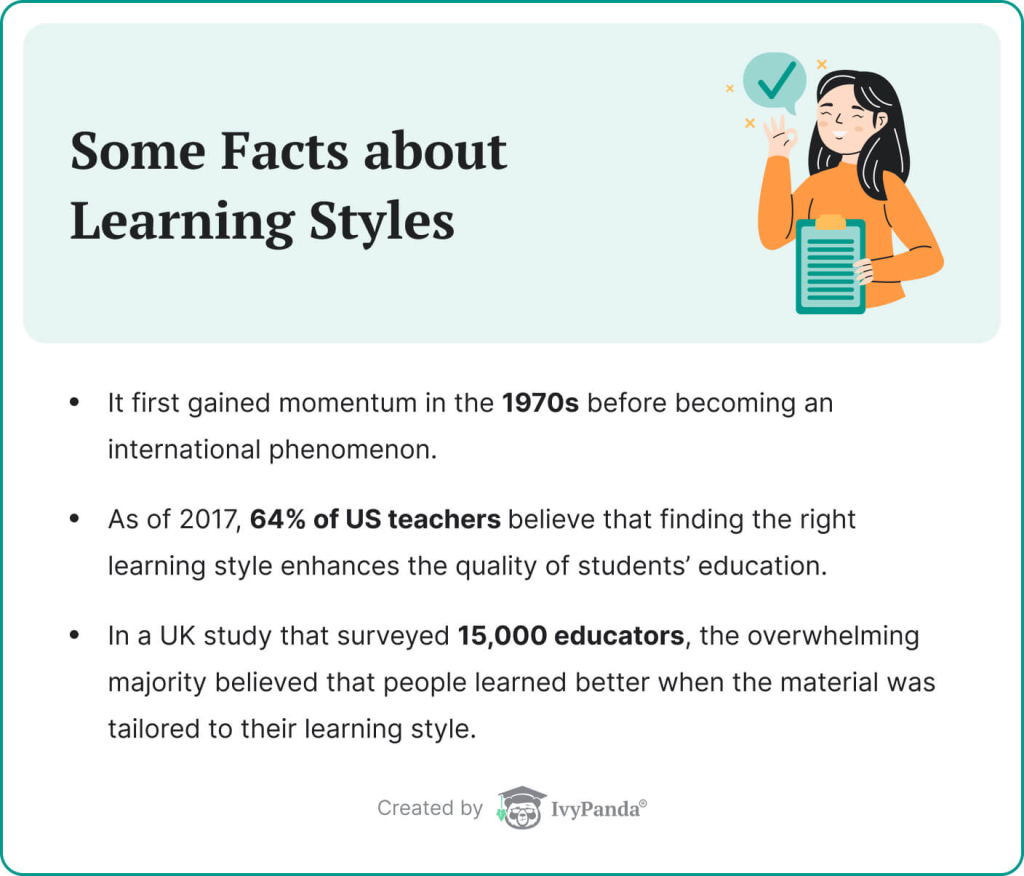
The 8 Learning Styles
The theory of learning styles has gone through an impressive evolution throughout its history. This concept began with three types known as VAK (visual, auditory, and kinesthetic). Later on, another type (read/write) was included, turning VAK into VARK. Here, we briefly describe what each component of this acronym stands for.
- Visual. Visual learners prefer informational intake as charts, diagrams, and maps. However, they don’t always work well with videos and images, as they require shapes and patterns to comprehend information. They often work with mind maps and flowcharts to improve their educational process.
- Auditory. This style emphasizes the use of spoken word. Audio learning involves listening to lectures, audiobooks, and podcasts about different subjects. Such students better comprehend concepts when explaining them out loud.
- Kinesthetic. With kinesthetic learning, you get a lot of hands-on experience. For example, a person may not quite understand the experiment on paper but conducting it makes everything fall into place. Hence, practice, simulation, and examples are critical in this study method.
- Reading/writing. As the name suggests, reading/writing learners process information primarily through these activities. It involves reading many scientific papers, textbooks, and nonfiction works. Such students excel at written assignments and quizzes.
These four learning types aren’t the only ones in existence. Many proponents of this theory believe that there are many more educational styles. Psychologist Scott Barry Kaufman even wrote that there were as many as 170 learning types. We’re not going to cover all of those here. Instead, we will talk about the additional four styles that professionals acknowledge when discussing this theory.
- Logical. This approach relies on logic and analysis in understanding different subjects. It has students search for connections, causes, results, and patterns. They excel when being asked interpretive questions and utilizing problem-solving skills.
- Social. The social method encourages group studying. It allows learners to gain additional insights and hone social skills. Sometimes, sharing stories and role-playing are involved in group activities.
- Solitary. This learning style is reserved for those who prefer to study by themselves. They excel when not being bothered by other learners and focusing on solo assignments. It highlights their problem-solving skills and individual qualities.
- Natural. Students using this approach need to be in a natural environment. They learn better when outside. While only sometimes available, the method is effective under the right circumstances.
📏 Learning Styles: Facts and Myths
As we have covered above, learning styles are appealing because they make intuitive sense. But despite copious amounts of research, there is no empirical evidence that supports the learning styles foundation. That is why some people want to eliminate learning styles entirely, stating that the methods have no apparent advantages. On the other hand, there are adamant defenders of the theory despite its flaws.
As with many other educational myths, there is a lot of misinformation concerning learning styles. It becomes easy to lose sight of the truth when at the epicenter of heated debates about this theory. That’s why in this section of the article, we want to establish what’s fact and what’s fiction.
People learn better when adhering to their learning styles exclusively.

Many educators have already integrated this belief into their teaching. However, it is important to understand that this statement is a myth. Students learn better when using a combination of methods. For example, when studying plants, it’s possible to use kinesthetic, reading, and visual approaches to extract as much information as possible.
There are no studies to indicate that using only one style helps people memorize things better. Their combined strengths activate different areas of the brain. When encountering new information, this mix of educational methods helps optimize comprehension.
Effective learning involves a variety of approaches.

This statement is true as people use different learning methods in a collaborative manner. For example, people who study music often read notes and listen to recordings at the same time. This way, they work with both audio and text.
The same principle applies to other disciplines, such as physics and chemistry. Combining theoretical knowledge, experiments, and real-life experience can go a long way. Learners should utilize methods that align with their study habits and preferences when approaching new subjects, but also be sure to travel outside their comfort zone. You can try out completely new learning strategies or combine tried and true methods to reach a whole different level of understanding.
If learning styles aren’t real, everything should be taught the same way.

There’s no universal way to study or teach. Every subject, topic, and idea can be presented in a myriad of ways and each piece of content can use a different learning method. For example, an outside experience in nature benefits students when learning about local flora and fauna. However, simply observing the plants will not explain their inner biology or the process of photosynthesis.
This is why picking just one way to learn limits the scope of the subject, and hinders one’s learning experience. Both teachers and students should be conscious of this fact when choosing the best way to present or absorb information.
People have their unique learning preferences.

Just like everyone has preferences in art, music, and literature, they also have educational preferences. Preferences may change over time and can be highly varied from one situation to another. It is important to vary your approaches to education to ensure that you get the most out of your subject.
🔬 Learning Styles vs. Learning Preferences
These notions may sound similar but they have notable differences that are crucial to understand. Learning styles relate to how a person tackles new information, while preferences identify the conditions one needs to learn better.
Learning styles:
- Educational style refers to a person’s way of absorbing information (audio, image, text, touch).
- They are categorized into various models.
- Each format has preferred teaching aids, such as diagrams, experiments, lectures, or study books.
- Learning styles often have a social aspect (whether a person learns better independently or in a group).
- Working in a structured or unstructured environment is also a significant factor.
Learning preference:
- Study preferences cover how a person learns, including their choices and tendencies.
- For example, they may study better in the morning or the afternoon.
- Preferences are influenced by an individual’s past experiences, background, and culture.
- Preferences aren’t set in stone and vary from subject to subject.
- They can also change as time goes by – for example, as a person grows and develops or discovers more effective study methods.
🥽 Study Methods for Different Learning Preferences
This part of the article covers different educational approaches and their features. Remember that you don’t have to focus on only one strategy all the time. We recommend that you give all of them a try, even if they are different from your preferred methods. This way, it is possible to continue training your brain and optimizing your learning.
Visual Approach
- Use demonstrations. If you need help understanding a concept, see it in action. Look for visual demonstrations on online platforms like YouTube. Seeing something happen makes it easier to understand it.
- Make outlines. Outlines are an excellent tool for students as they allow you to structure large amounts of data concisely. Use headers, sub-headers, and bullet lists to organize information.
- Create graphs and charts. When the situation calls for it, put data into charts and graphics. Keep information delivery simple but creative enough that you instantly know what a chart is about after looking at it for a couple of seconds.
- Utilize flashcards. Use flashcards to build your vocabulary and knowledge. Add symbols and pictures to remember the information better. You could also ask a friend to give you quizzes based on these cards.
- Take practice tests. Write and then complete several practice tests. Utilize chapter notes, class assignments, and study guides to craft your tests.
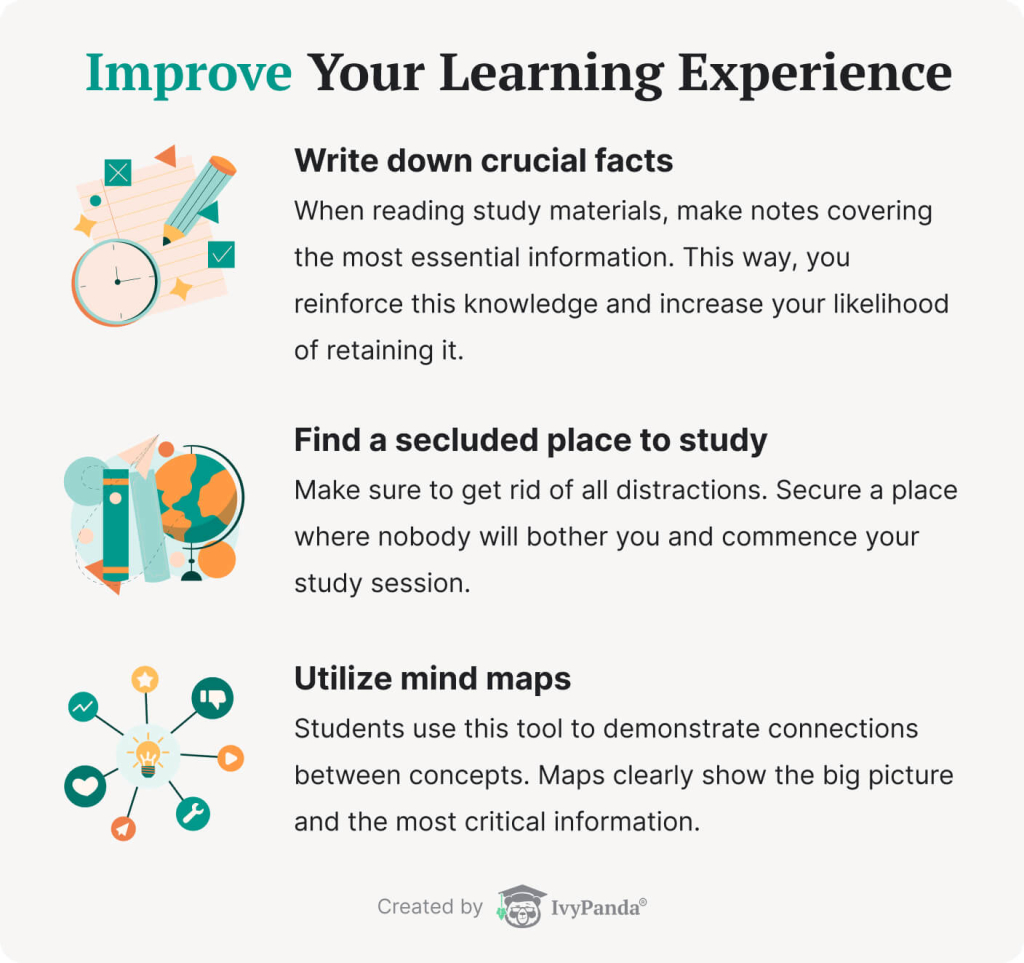
Auditory Approach
- Listen to audiobooks. Students benefit from listening to recorded books. There are many good narrators you can check out, including George Guidall and Stephen Fry. If they read too slowly, it’s possible to speed up the audio.
- Explain concepts to fellow students. If you are having trouble grasping a concept, try explaining it to someone else. This helps form and clarify ideas.
- Use songs and rhymes. Many people use melodies and parodies to remember concepts. This can be as simple as studying to the tune of ‘Old MacDonald Had a Farm’. It makes the process more fun and engaging.
- Participate in discussions. Debates and discussions help students bounce ideas off one another. Expose yourself to other points of view and make your opinion heard. This leads to more effective analysis and comprehensive understanding of various issues.
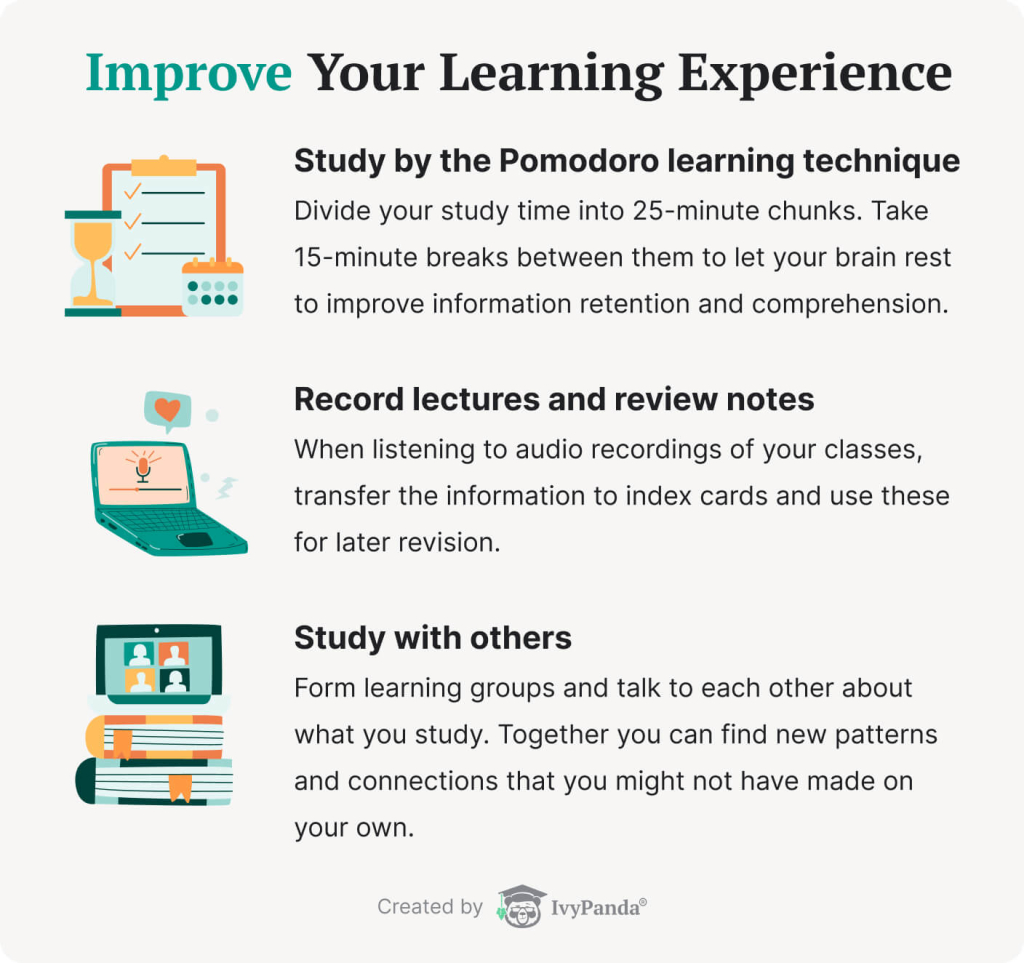
Kinesthetic Approach
- Stand up when learning. If you have trouble concentrating, stand up. There are many benefits to this practice. In this pose, the body is more connected to the study process. Buy a standing desk, or a book stand to concentrate longer and remember more.
- Combine learning and exercise. When learning, do physical exercises between each chapter. Ask someone to quiz you while you work out. It’s an excellent method of keeping the brain active.
- Tense and relax. It’s also good to tense your body and limit movements to 5-10 seconds. Tighten particular muscles for that period and then relax them for tension relief.
- Tap into your creativity. Try approaching topics with different tools and study aids. Use figurines, blocks, and other physical aids to visualize ideas. Draw pictures to fix images in your mind’s eye better.
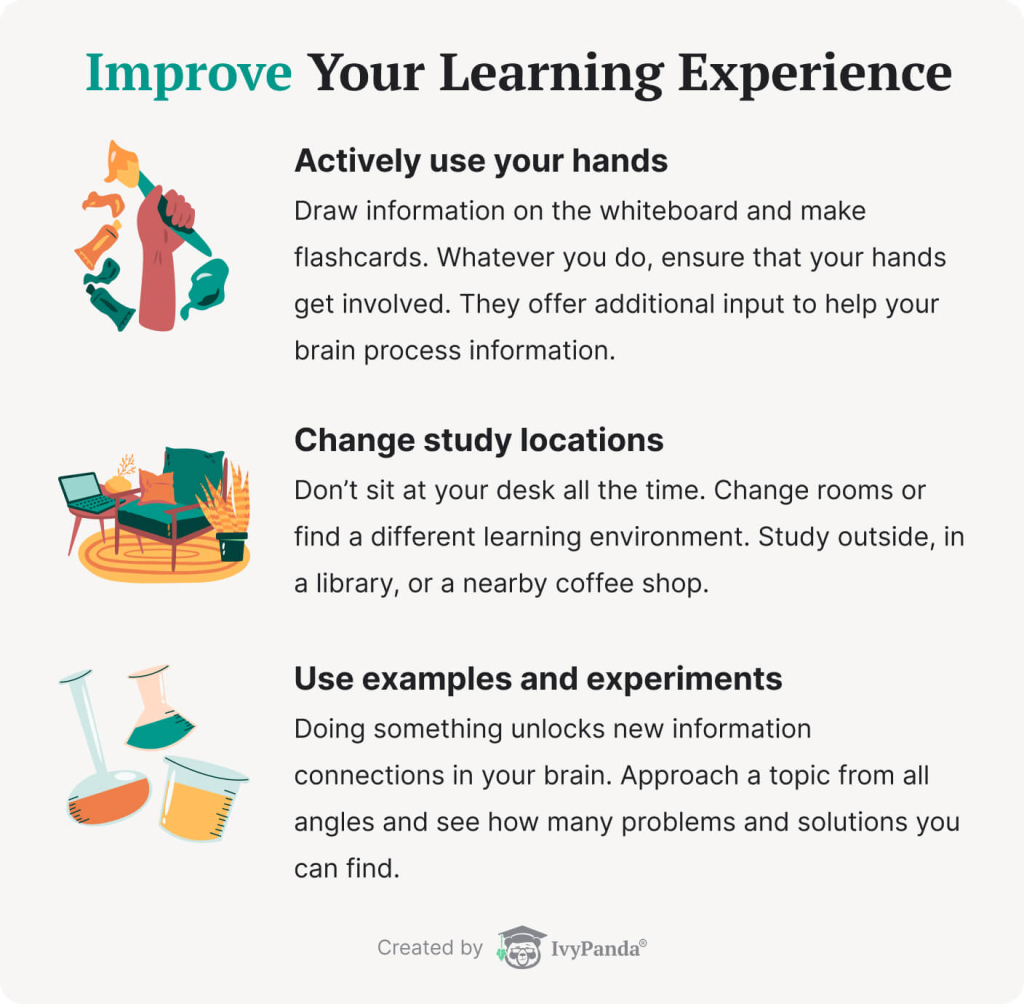
Read/Write Approach
- Cornell notes. Cornell notes are a great study aid. They are divided into four parts. The first contains the date and title. Second consists of two columns — one with notes and the other with keywords and comments. The final part is a summary of the page.
- Highlight and annotate. Highlighting parts of the text and making margin notes is one of the most common study strategies. Enhance this process with questions, summaries, and comments.
- Mind-mapping. Use mind maps to organize information. In this creative process, start with a central idea and branch out to related topics and concepts. Do this by-hand or utilize the power of online tools.
- Use abbreviations and symbols. Another sound strategy revolves around the use of symbols and abbreviations. They make note-taking easier, discarding the need to copy everything word for word. Create a system of symbols and abbreviations for faster writing.
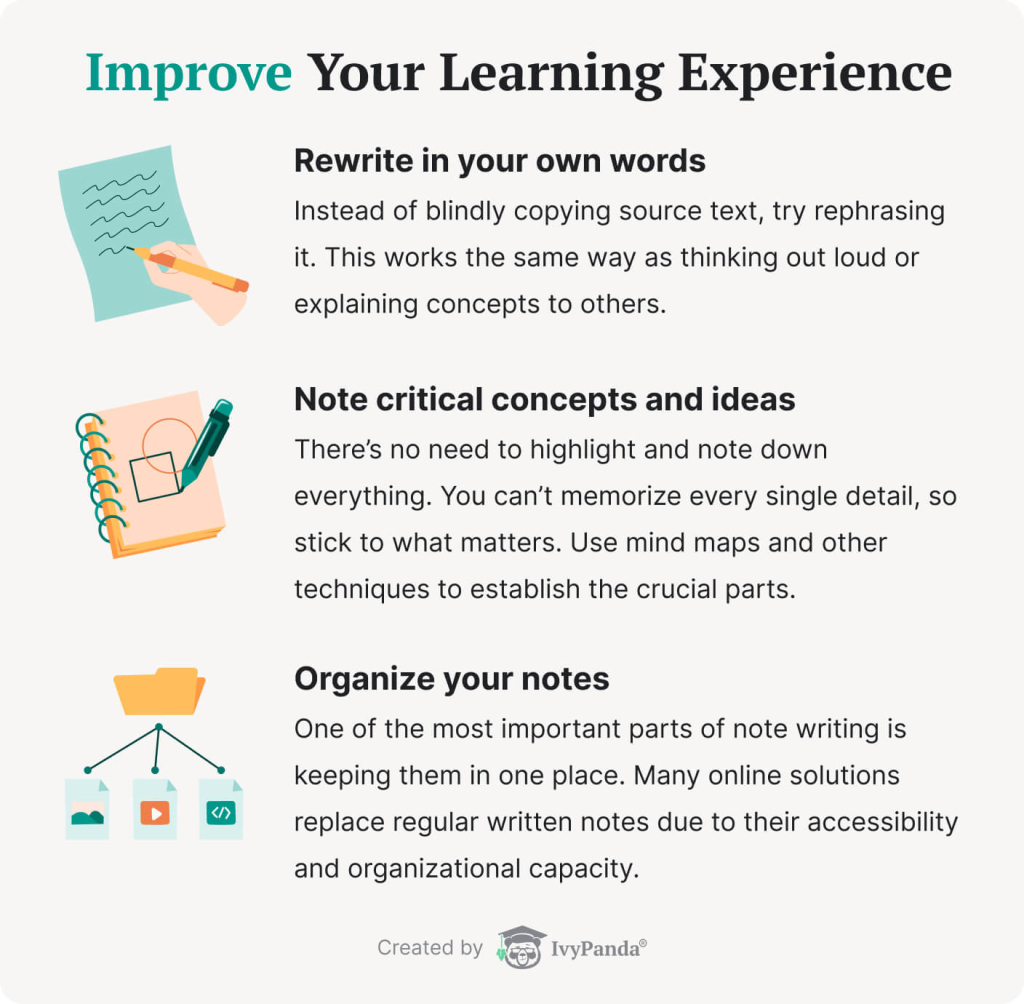
🧪 Combine Your Learning Preferences
Combining different learning strategies is highly beneficial. The human brain remembers information best when it processes data in a variety of ways. Below are several types of mixed education approaches:
- Use hands-on experience and audiobooks. For example, when you conduct an experiment, like examining a bacteria sample, listening to an audiobook chapter on the related matter enhances your understanding of it. This has elements of both kinesthetic and auditory methods which many students favor.
- Combine video and text. Learners double their information intake with one simple trick: putting the subtitles on. This method combines auditory, read/write, and visual approaches. The next time you watch a documentary or TED talk, don’t forget to do this. It’s also a great practice when learning new languages.
- Listen and take notes. When listening to podcasts and lectures, make notes along the way. Then, highlight the most crucial information and structure it with bullet points, headers, or mind maps. This is one of the most common mixed-learning methods that uses a combination of auditory and read/write techniques.
- Use diagrams in tandem with physical representations. Physically touching and studying a subject or a model creates new connections for your brain. Make diagrams as you learn the composition of objects. This combination of visual and kinesthetic approaches is most common when studying anatomy.
- Read about natural phenomena and observe them in real life. For example, the next time you read about weather-related phenomena, witness them. If you study different cloud types, venture outside for a look. You’ll get theoretical information and see it in practice, combining read/write and visual aids.
We hope this article improves your knowledge of learning methods. If you know someone interested in learning methods and the myths about them, introduce them to our work! Thanks for reading.
📎 References
- Learning styles – the myth persists – Asher Cashdan, The British Psychological Society
- Learning Styles in Education: A Critique – Jackie Gudnason, BU Journal of Graduate Studies in Education
- How Common Is Belief in the Learning Styles Neuromyth, and Does It Matter? A Pragmatic Systematic Review – Philip M. Newton, Atharva Salvi, Frontiers
- Stop propagating the learning styles myth – Paul A. Kirschner, ScienceDirect
- Learning Preferences Instead of Learning Styles: A Case Study of Hospitality Management Students’ Perceptions of How They Learn Best and Implications for Teaching and Learning – Cynthia S. Deale, International Journal for the Scholarship of Teaching & Learning
- Studying 101: Study Smarter Not Harder – The Learning Center, University of North Carolina at Chapel Hill
- 25 Scientifically Proven Tips for More Effective Studying – Joy Cromwelle, My Degree Guide
- How to Utilize the Combination Learning Model – Misty Hance, Graduate Programs for Educators
- The Definition of Combination Learning – TeachThought Staff, TeachThought
- Learning Styles and Preferences – a quick blended learning guide – Hubken Group


